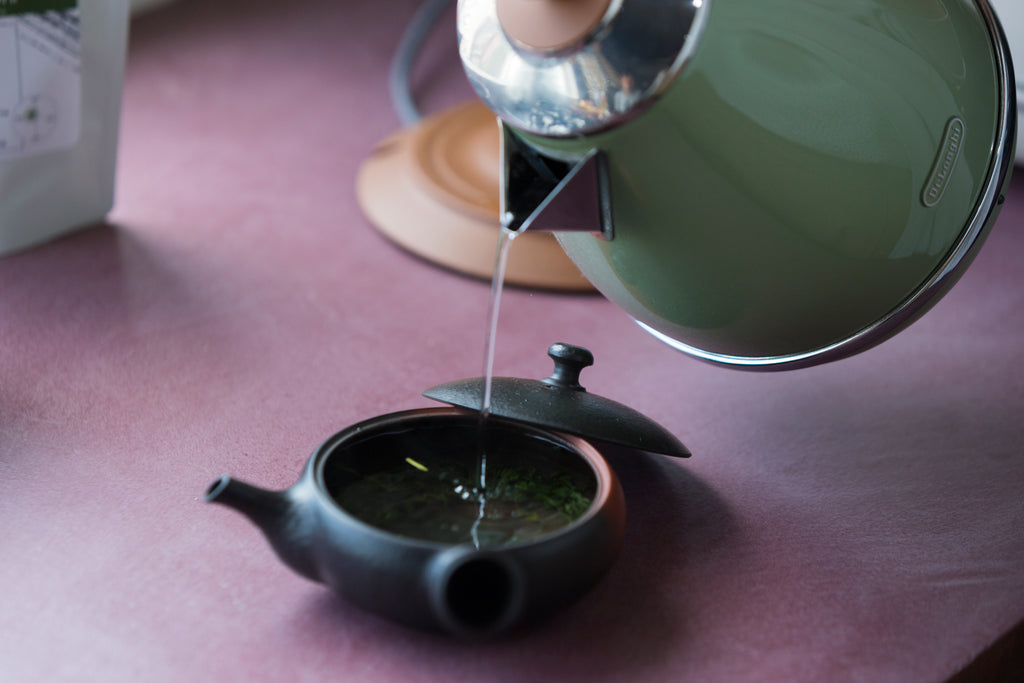When you hear that different types of green tea have different brewing methods, you may think that green tea is just difficult. No, it's not. The key factors to brew Japanese green teas deliciously are very simple.
Here, we will introduce standard brewing methods for each type of tea, but you can also discover "your own brewing method". It should be definitely exciting experiment!
1. Brewing Temperature
The most important factor in brewing green tea is the temperature of the hot water. It is said that catechin, which is the source of bitterness and astringency of tea, tends to leach out well when the temperature of hot water exceeds 80 ° C. Therefore, if you want to drink tea with less bitterness and astringency, we recommend brewing tea with hot water below 80 ° C.
In order to brew at the best temperature, we can use a kettle which features an adjustable temperature setting. Even if we don’t have that, we can control temperature using “yuzamashi (water cooler)”. Generally, the temperature of hot water decreases by 5-10 ° C each time water is transferred to a different vessel, so yuzamashi can be used to lower the hot water temperature.
When pouring hot water to a yuzamashi, the hotter the water is, the temperature is lowered faster.
Hot water above 80 ℃: Temperature will drop by 20 ℃ per pouring
Hot water below 80 ℃: Temperature will drop by 10 ℃ per pouring
If you want to make more fine adjustments, like lowering hot water above 80 ℃ by 5~10 ℃ , it is possible by preheating the yuzamashi.
2. Brewing Time
Next important thing is the time to brew the tea. The best brewing time has been determined in the long history of Japanese tea, since there is a close relationship between brewing temperature and time; hot water leaches faster, and cold water takes longer to brew.
The most standard method is "brewing 1 minute at 80 ° C". If above 80 ° C, brewing time is 30 sec. If brewing below 80 ° C, the leaching time is extended by 30 seconds each time the temperature drops by 10 ℃.
3. The Type of Water
The type of water has a lesser effect than the brewing temperature and the time, but it does also affect the taste and aroma of green tea. Especially the water hardness is important.
Since tap water in Japan is soft water, which is low in minerals, a brewing method of Japanese tea has been determined under the condition of soft water. However, in countries other than Japan, there are many areas of tap water with a high mineral content called hard water. Hard water is good for black tea, but not for Japanese tea. If your area is hard tap water, using bottled purified soft water will give you the same taste of green tea as you would drink in Japan.
However, the real fun of brewing Japanese tea is that you can enjoy different tastes when you brew differently.
There was a case that the tea was brewed overseas without knowing it was hard water but it was unexpectedly delicious and recognized as suitable for hard water. It does not mean that you can't drink delicious Japanese tea unless it is brewed with soft water.
Brewing Each Type of Japanese Teas Perfectly
Based on the above key factors, we introduce the brewing methods for each type of Japanese green tea.
Sencha: Sencha is best served with hot water at 80 ℃, since sencha is a tea that enjoys a balance between umami, sweetness, bitterness and astringency. As it is brewed at 80 ℃, the best brewing time is 1 minute. Add 3g of tea leaves to the teapot and infuse with 70ml of hot water for 1 person.
Gyokuro: The best temperature for gyokuro is 50-60 ℃. Gyokuro is a tea that reduce bitterness and astringency as much as possible and enjoys a rich umami and sweetness. As brewed at 50-60 ℃, the best brewing time is 2– 2.5 min. Add 3g of tea leaves to the teapot and infuse with 20ml of hot water for 1 person. You may be surprised that it is very small amount of water, but gyokuro is a tea that you can enjoy a small amount of rich umami taste on your tongue.
Hojicha: You can use boilng water at 90-100 ℃ for hojicha. Hojicha has less catechins as it is decreased during roasting process. So it doesn’t represent bitter or astringent taste even brewed at high temperature. (Catechin is a component that is easily leached with hot water.) Hojicha also has a toasty fragrance that rises when brewed at a high temperature. The brewing time is 30 sec. Add 3g of tea leaves to the teapot and infuse with 100ml of hot water for 1 person. Hojicha is smooth and not too strong in taste, so it is also suitable when you want to hydrate.
We have introduced the "standard" method of brewing Japanese teas so far. However, there are as many brewing styles depending on brewers' preferences. Enjoying such varieties, and seeking your own style, both are the world of Japanese tea !

